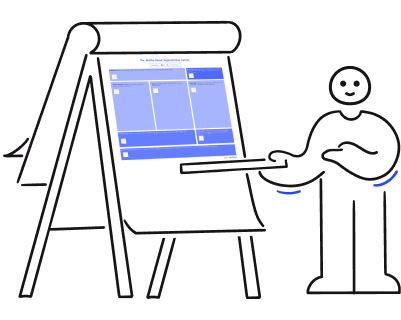A learning management system (LMS) is a software-based platform that supports the administration and delivery of corporate courses, training programs, and learning and development programs. An LMS is typically delivered as a hosted service or software as a service (SaaS), meaning it is Internet-based and requires no installation, thereby making it perfect for modern learners.
An LMS helps companies deliver training materials and because it's accessible on mobile devices, it makes it easy to reach people wherever they are. An LMS works well when it's scalable and adaptable to the needs of your learners. It offers features like course creation, scheduling, reporting, analytics, and much more. Most importantly, it allows you to combine multiple types of learning into one cohesive experience.
The power of an LMS as a training management system lies in its ability to support a wide range of learning strategies, including both formal and informal methods of learning. For example, you might use an LMS to provide training on how to perform certain tasks, certify employees, promote compliance, or develop your brand's culture.
Empower your organization with the skills-based canvas.

What's in this article
Who needs an LMS?
LMS systems are used globally, across numerous different industries, and for enterprises of all size. They are useful for corporate training, so they are used by SMBs, non-profit organizations, cooperatives, etc.
Types of learning management systems
The benefits of a learning management system are evident, but it can be difficult to decide what type of LMS will most benefit your company and your learners. Below is a list of some of the most common types of learning management systems on the market.
Cloud-based vs. on premise
A cloud-based learning management system (LMS) is hosted on a secure server and allows users to use it via multiple devices, including smartphones and tablets. This type of software offers several advantages over traditional LMS solutions. Cloud-based LMS such as Enterprise LMS are easy to implement, require no upfront costs, and offer scalability. They're often used by organizations, such as SMBs, non-profits and coops to provide online training courses.
On-premise LMS are traditionally offered as standalone products, meaning they must be purchased and licensed separately from the rest of the courseware. These systems are usually customized to meet the specific needs of each organization.
Closed-source vs. open-source
In both web-based and installed software, you have closed-source and open-source learning management systems. However, there is no such thing as a purely open-source system. Open-source LMS primarily derive their name from the fact that they are free. They are also considered open-source because they often have communities of users.
This kind of system has its advantages and disadvantages. On one hand, it gives you freedom. On the other, it comes with responsibilities. You must accept that everything you do is being watched. If you want to make changes to something, you must ask permission. If you want to use someone else's code, you must acknowledge where it came from.
Objectives of a Learning Management System
The main objective of eLearning systems is to enhance the learning experience and manage and track online training. An eLearning system does not just deliver content. It also manages enrollment, tracking, and reports. Most eLearning systems are web-based and are utilized in various organizations for training purposes.
They are used in various industries and settings like finance services, compliance training, computing-based training, online assessment, collaborative learning, application-sharing, etc. Some eLearning systems also incorporate a performance management system that includes employee appraisals, competency management, skill gap analysis, and so on.
1. Enable mobile learning
One of the key purposes of learning management systems is to enable mobility while learning. A mobile LMS provides your team with instant access to organizational training materials whenever they're needed. This gives employees more freedom to learn without being tied down to their desks.
2. Streamline learning processes
An online learning management system allows employees to easily access important information about company policies, procedures, and processes through a central hub. Employees can access important documents such as job descriptions and handbooks from anywhere. They also have one place to go to find helpful tutorials, videos, and Q&A sessions.
3. Engage employees
These days, employees are more distracted than ever and companies are paying the cost. Learning management systems provide workers with a blended learning experience. Content is presented in various forms including written, audio, video, etc. to support learning objectives.
4. Track and assess performance
An LMS is a great employee training tool. Apart from imparting instruction, it can enable businesses to keep track of the progress made by their employees. It allows businesses to check in to see how well their employees are doing, and whether or not they’re following through with the required tasks.
Employees and managers can also utilize the LMS to check if anyone needs to review certain principles to get a better understanding of them. The LMS can also help ensure that training goals are being met.
5. Save money
A learning management system saves businesses money because they do not have to pay trainers to travel and update employees on new materials. By setting up an LMS, businesses remove the overhead associated with teaching new information to employees, such as compliance training costs, boarding, lodging, etc.
Benefits of learning management systems
- Provides better control over the entire training process. You can easily set up the schedule for your training sessions, assign tasks to team members, and monitor how well they are performing.
- Helps create a balanced learning experience. Each learner requires a different approach to learn effectively. A good LMS allows you to customize the training session, according to the learner’s needs.
- Makes it easy to communicate with learners. With an LMS, you can send messages to your learners via email, SMS, chat, etc. This enables you to keep your learners engaged throughout the training program. Users of Workleap LMS benefit from the Zapier integration to unlock this tool.
- Improves collaboration among trainers and administrators. Everyone has their own account but different roles can be assigned to optimize collaboration.
- Allows you to make changes quickly. In case there are any mistakes during the training process, you can fix them immediately.
How to choose a modern LMS?
With so many learning systems on the market, it can be difficult to know which one will be best for your company. Here are tips to help you make an informed decision when choosing a modern LMS:
- Identify your needs. With 600+ learning platforms to choose from, selecting one isn't easy. There are numerous factors to consider when choosing the best solution for your organization, such as the type of learners you have, the type of system that will work best and how they will access the system.
- Decide the features you need. After defining your learning management system (LMS) needs, it's time to determine the specific features, functions, and capabilities you want. This step involves identifying the learning goals, objectives and audience demographics. Once you've determined these things, you'll want to think about how the system will support your organization's current practices and future plans.
- Browse the market. The third step in the vendor selection process is to explore the market. This includes researching the different types of learning management systems, comparing products based on functionality, price, and support options.
The best Entreprise LMS
If you want to get the most out of your learners and reach your corporate goals, a digital learning solution is the way to go. In today's digital age, learning environments are ever-changing and enterprises need to adapt to these changing environments. The best way to manage the learning process is to invest in a learning management system.
At Workleap LMS, we prioritize learner engagement and customer satisfaction. We’ve designed the best online management platform used for teaching and learning. From user monitoring to personalized learning paths, our LMS system is specially designed to help your business grow.
Each LMS client creates their own training platform and chooses a package depending on the nature of their project. To help you better understand and use our tool, we attach great importance to educational content.
Discover, manage, and grow your team’s skills to unleash their potential and retain your rising stars.




